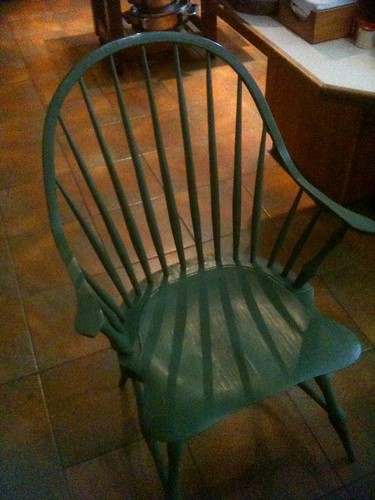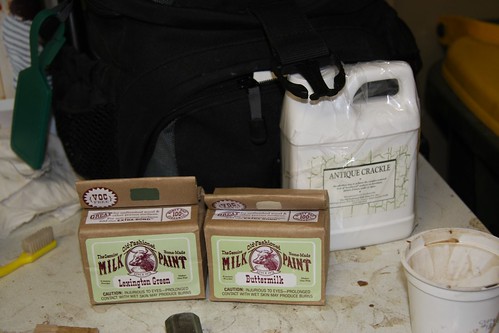 Thanks: 0
Thanks: 0
 Likes: 0
Likes: 0
 Needs Pictures: 0
Needs Pictures: 0
 Picture(s) thanks: 0
Picture(s) thanks: 0
Results 16 to 30 of 30
Thread: authenticity ... milk paint
-
1st December 2010, 07:49 PM #16

I seem to recall that milk paint was used by Windsor chair makers. Considering the different types of wood they used to make a chair they would have had to use something to tie the finish together.
As for the provenance of milk paint I will have to refer you to this:
The History of Milk Paint - Real Milk Paint ®
While this is obviously a commercial organisation we're not talking about some multi-national paint company. I'm going to take them at their word.
-
1st December 2010 07:49 PM # ADSGoogle Adsense Advertisement
- Join Date
- Always
- Location
- Advertising world
- Posts
- Many
-
2nd December 2010, 12:41 AM #17
 New Member
New Member











- Join Date
- Dec 2010
- Location
- Utah
- Posts
- 2

Interesting discussion. I still stand by my opinion that milk paint is a nice myth. Two references, wow I found several milk paint recipes that were all whitewash. The stuff just wasn't used to paint furniture. Distemper paint was used on furniture.
I will cover the subject in my next book on C19 furniture finishes, hopefully it will read like a grade twelve paper.
Stephen
-
2nd December 2010, 06:05 AM #18

What laboratory testing was done on the old paint that 'confirmed' it was lead paint? It is likely lead was a pigment added to the paint and possible it had an oil glaze topcoat. That would appear in 'laboratory testing' to contain lead and oil wouldn't it. Were mass spectrometry or electrophoresis tests conducted to determine the presence or otherwise of milk protein? It's poor form not to mention what specific types of tests were done, it ends up reading like a tooth paste commercial.
Cheers
Michael
-
2nd December 2010, 07:08 AM #19
-
2nd December 2010, 07:59 AM #20

I was going to say ouch!
but this little snippet...
"There is an occasional reference to ‘casein’ paint made from cheese and used by artists as a light duty paint, but it is not milk paint. Casein is a phosphoprotein that was developed in 1841, so the history is not that old."
...intrigued me again so I decided to google 'casein 1841'
It turns out the origin of the WORD 'casein' dates to 1841, eg Casein | Define Casein at Dictionary.com (about 1/3 down under word origin and history) . I am so disappointed that this was interpreted to mean the casein protein was developed in 1841. I am even more disappointed that little effort went into checking the facts before making sweeping statements to a wide audience.


Cheers
Michael
-
2nd December 2010, 08:50 AM #21
 Yes, two without even trying very hard and both in books written in the the 19th century in the US. Both calling it "milk paint". You say you couldn't find any reference to it, so I guess you didn't look very hard.Two references, wow I found several milk paint recipes that were all whitewash.
Yes, two without even trying very hard and both in books written in the the 19th century in the US. Both calling it "milk paint". You say you couldn't find any reference to it, so I guess you didn't look very hard.Two references, wow I found several milk paint recipes that were all whitewash.
Your argument appears to hinge on what you define as the fine line between whitewash and paint, which is incredibly pedantic, even by my standards."I don't practice what I preach because I'm not the kind of person I'm preaching to."
-
7th December 2010, 07:29 PM #22
 sawduster
sawduster











- Join Date
- Aug 2010
- Location
- Townsville Qld
- Posts
- 72

Plain and pleasant talk about fruits ... - Google Books Found this while looking for an answer - still looking but at least the source document is dated 1859
^ Beecher, Henry Ward (1859). Plain and pleasant talk about fruits, flowers and farming. Harvard University: Derby & Jackson. p. 187.
Can't find too much else out there except for the same blurb being repeated on every website I check. Paint thousands of years old used by caveman etcI make sawdust with powertools.
-
5th January 2011, 04:55 PM #23

He's at it again! The first two hits for 'venice turpentine' on Google basically covers the lot. "Solid" turpentine? I can't accept that. Turpentine is distilled sap/resin and not a solid.
As for "1 ½ ounce indicates this is in solid not liquid form"... of course it's liquid! What is an ounce if not 1/40th of a quart (or 1/32nd in the US)? Unless the quart of "Rectified spirits of wine" is a US dry quart.
Oh the perils of becoming a Google smart!.
I know you believe you understand what you think I wrote, but I'm not sure you realize that what you just read is not what I meant.
Regards, Woodwould.
-
5th January 2011, 10:05 PM #24
 New Member
New Member











- Join Date
- Dec 2010
- Location
- Utah
- Posts
- 2
-
6th January 2011, 11:19 PM #25
 gravity is my co-pilot
gravity is my co-pilot











- Join Date
- Apr 2010
- Location
- Melbourne
- Posts
- 562
-
7th January 2011, 07:28 AM #26

According to the OED (I never heard of that acronym before – thanks) turpentine is an "oleoresin secreted by certain pines and other trees and distilled to make rosin and oil of turpentine". Oleoresins are not solids and the 'turpentine' referred to is obviously the wider acceptance of the word – the volatile spirit.
.
I know you believe you understand what you think I wrote, but I'm not sure you realize that what you just read is not what I meant.
Regards, Woodwould.
-
10th January 2011, 11:32 AM #27

I just painted a Windsor chair that I made at a course at the Melbourne Guild of Fine Furniture, before Christmas. I painted it with milk paint..It comes from America as a powder.
I am learning, slowley.
-
10th January 2011, 12:34 PM #28
-
30th January 2011, 05:27 PM #29

I've worked within the artists paint manufacturing business for 20 odd years and have read just about every ancient recipe book and treatise there is on paints, resins, varnishes, oils etc. And I have never seen any recomendation of using a milk/casein paint on furniture, except for in the last 15 years so called "experts in folk art" who promote DIY painting of hideous flowers on mdf gegaws. Most so called milk paints sold are acrylics that have been adulterated with fillers to get that horrible chalky look. Plaka made by pelican was a casein gouache that was made till a few years ago for designers and sign writers, I spilt some on a chair once and it would continually come off on to my trousers, thus suggesting that it was useless as a furniture finish.
Ps. Talens sell a good Venice turpentine, expensive but the real thing with no dilutive
IanLast edited by Ian Wells; 30th January 2011 at 05:30 PM. Reason: Auto spell interference
-
30th January 2011, 05:38 PM #30
Similar Threads
-
Colouring home made milk paint?
By markharrison in forum FINISHINGReplies: 8Last Post: 14th July 2009, 09:45 AM -
porters milk paints
By astrid in forum FINISHINGReplies: 10Last Post: 30th December 2007, 03:35 PM -
Two white milk?
By ozwinner in forum NOTHING AT ALL TO DO WITH WOODWORKReplies: 5Last Post: 20th September 2006, 09:54 PM -
milk on her head
By Farm boy in forum Hatches, Matches & Dispatches. Birthday greetings and other Touchie-feelie stuff.Replies: 5Last Post: 21st November 2005, 10:47 PM -
Durability of Milk Paint
By Bunyip in forum FINISHINGReplies: 2Last Post: 24th May 2004, 06:23 PM




 Reply With Quote
Reply With Quote
 This is the chair.
This is the chair. ">
">


 Brilliant! Have a greenie on me!
Brilliant! Have a greenie on me!

